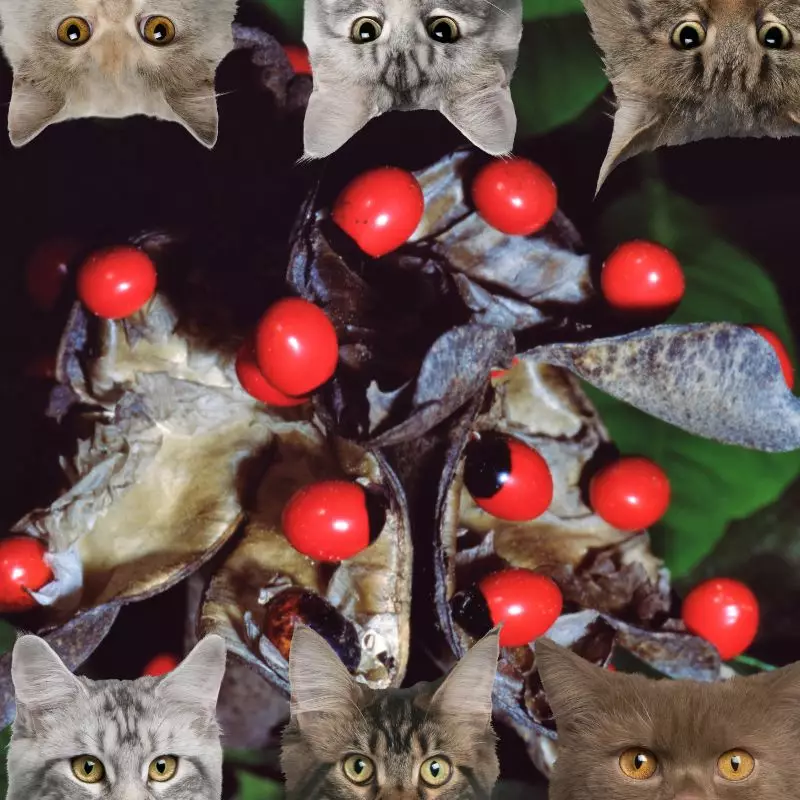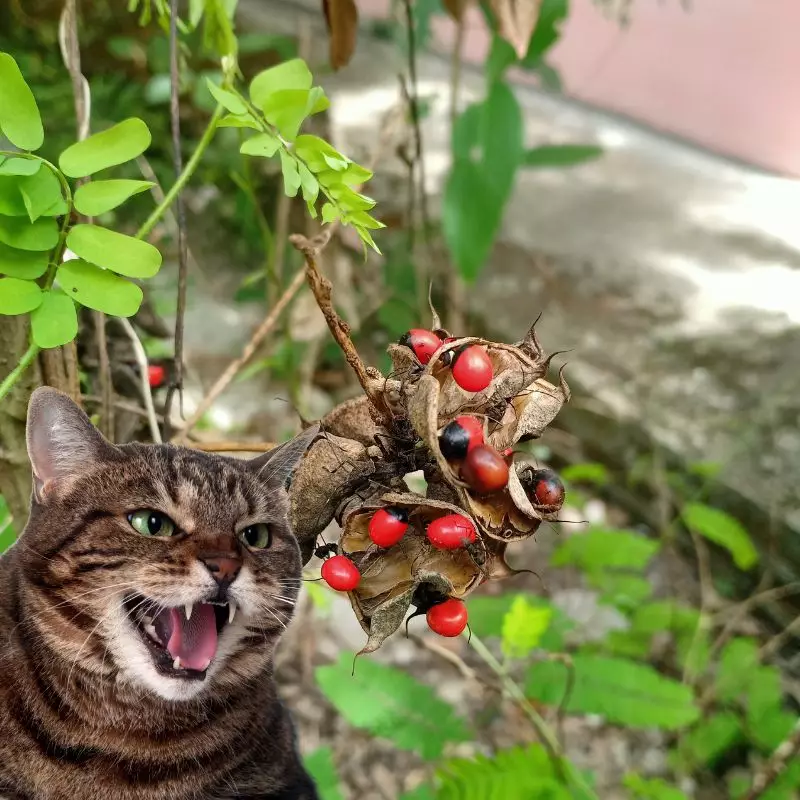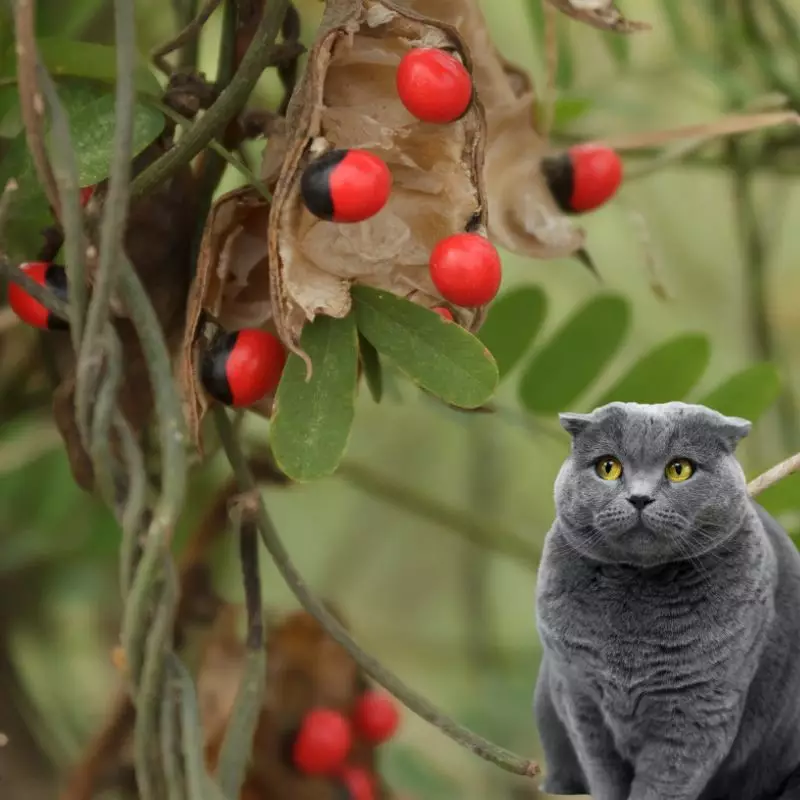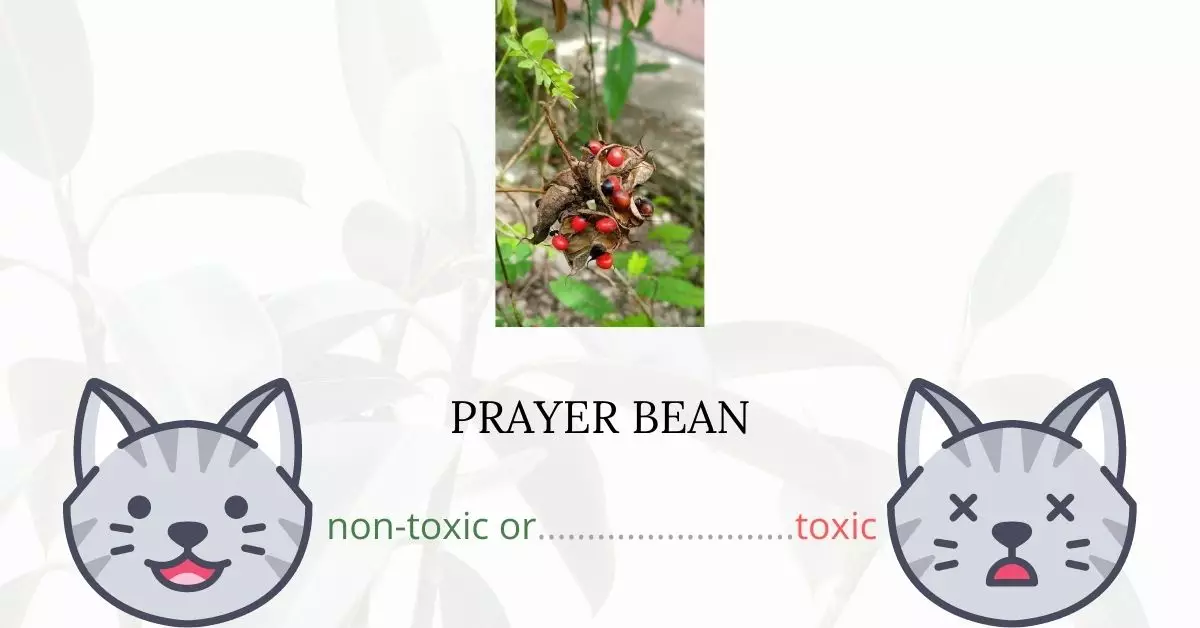The Prayer Bean plant, scientifically known as Abrus precatorius and commonly referred to as the rosary pea, Seminole bead, Indian bead, Indian licorice, love bean, or lucky bean, is unequivocally toxic to cats. It contains two primary toxic compounds, abrin and abric acid, which become particularly harmful when the seed coat is damaged or destroyed, exposing the seeds that represent the greatest risk to cats.
This article is crafted in collaboration with a team of seasoned Doctors of Veterinary Medicine (DVMs). Their invaluable contributions enable us to provide accurate, credible, and the latest information on the potential dangers associated with various plants, specifically the Prayer Bean plant in this context, and their repercussions on cats. To reinforce the reliability of our information, we have also referred to high-authority resources such as ASPCA and PetMD for extensive insights on every plant discussed.
Cats that have consumed the seeds of the Prayer Bean plant may exhibit several symptoms, including but not limited to vomiting, diarrhea, tremors, heightened fever, and an accelerated heart rate. Immediate veterinary intervention is crucial to manage the toxicity and alleviate the distress caused by the ingestion of this plant.
Clinical Signs of Prayer Bean Poisoning in Cats

The ingestion or contact with the Prayer Bean plant can lead to an array of clinical signs in cats due to the presence of toxic compounds like abrin and abric acid. Here is a closer examination of the manifestations and underlying causes of each clinical sign:
- Severe Vomiting: This occurs as the body’s natural response to rid itself of the toxic compounds. It is an immediate reaction to the intake of the harmful substances found in the plant.
- Diarrhea: The ingestion of the Prayer Bean plant causes irritation and inflammation in the gastrointestinal tract, leading to frequent, loose, or watery stools as the body attempts to expel the toxins.
- Presence of Blood in Feces: The toxins can cause damage to the lining of the gastrointestinal tract, leading to blood in the feces due to internal bleeding.
- Elevated Heart Rate: The toxic compounds in the plant affect the cat’s cardiovascular system, causing the heart to pump faster in an effort to distribute essential nutrients and oxygen to vital organs rapidly.
- Tremors: The neurotoxic effect of the toxins in the Prayer Bean plant affects the nervous system and can lead to involuntary muscle contractions or spasms as the body reacts to the poisonous substances.
- Fever: A high body temperature is a common response to infection or inflammation in the body. The toxins in the plant trigger an inflammatory response, leading to an increase in body temperature as the body tries to fight off the toxic effects.
- Shock: Due to the rapid onset of severe symptoms and the body’s strenuous effort to combat the toxins, cats may go into shock, a life-threatening condition characterized by a sudden drop in blood flow through the body, leading to organ failure.
- Death: In severe cases, if the ingestion of the Prayer Bean plant is not treated promptly, the accumulation of the toxins can lead to multi-organ failure and, ultimately, death.
Recognizing these symptoms early and seeking immediate veterinary attention is crucial to managing the adverse effects of the Prayer Bean plant and increasing the chances of a favorable outcome for the affected cat.
First Aid and Treatment of Prayer Bean Poisoning in Cats

To remove any toxins that may still be inside your cat’s stomach, the vet will first induce vomiting. A 3 percent hydrogen peroxide solution, taken orally, can be used to cause vomiting. The vet can also give your cat activated charcoal, which absorbs toxins that haven’t yet reached his bloodstream. Finally, the veterinarian may decide to perform gastric lavage, which is a medical word for a stomach wash. This is done to eliminate any leftover poisons from the stomach cavity.
Sucralfate, a drug that hardens into a thick paste and coats the stomach to prevent future inflammation, can also be given to your cat by the vet. This is given after your cat has been induced to vomit in order to halt the vomiting and calm down his stomach.
Your veterinarian will give your cat intravenous fluids before, during, or after treatment to avoid dehydration and electrolyte imbalance caused by excessive vomiting which are both side effects of the medication. To ensure that the cat’s condition does not deteriorate, the veterinarian will monitor his vital signs throughout the treatment.
Recovery from Prayer Bean Poisoning in Cats

The prayer bean has a remarkably high concentration of poisons when compared to other toxic plants. This implies that your cat’s recovery isn’t certain, especially if you wait too long to seek treatment. If you can begin therapy right away, your cat will have a far higher chance of recovering.
Consult your veterinarian to see whether any adjustments to your cat’s food are required in the days following therapy. Because induced vomiting can be hard on your cat’s stomach, the vet may recommend that you feed him softer foods for a few days while he recovers.
Keep a close eye on your cat and contact a veterinarian right away if you think the symptoms are recurring or getting worse.
Prevention of Prayer Bean Poisoning in Cats
Make sure the prayer bean is no longer in your yard. If you’re not sure where your cat came into contact with this plant, keep him inside so he doesn’t come into contact with it again.
If you love plants but have cats at home, check out these lists:





